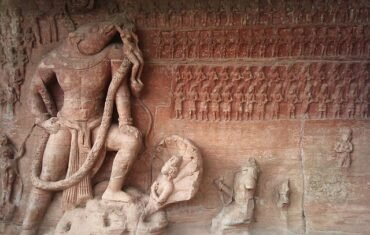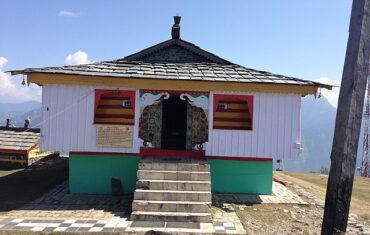Badrinath Temple is a town and a shrine in the Chamoli district of Uttarakhand, India. It is one of the four sites in India’s Char Dham pilgrimage and is also part of India’s Chota Char Dham pilgrimage circuit. It is dedicated to Lord Vishnu, who is worshipped here as Badrinatha or Badrinarayan. The town is located in the Garhwal Himalayas, on the banks of the Alaknanda river, at an elevation of about 3,100 m (10,000 ft).
The town lies between the twin mountain ranges of Nar and Narayan, which are considered to be the abode of Vishnu and his consort Lakshmi.
Location of Badrinath Temple

The Badrinath temple is about 525 km (326 mi) from Delhi city, which is well connected by flights, trains and buses from various cities in India. The temple can also be reached by road from nearby towns such as Haridwar, Rishikesh and Joshimath. The temple is located on the left bank of the Alaknanda river and offers a splendid view of the holy river and the snow-capped peaks.
Timing of Badrinath Temple
The Badrinath temple is open for darshan (viewing) from 4:30 am to 9:00 pm every day. The temple has four aartis (rituals) daily: at 4:30 am, 12:00 pm, 6:00 pm and 9:00 pm. The temple also has a special aarti called Maha Abhishek Aarti, which is performed at 4:30 am using water, milk, honey, curd, ghee and other substances. This aarti is considered to be very sacred and auspicious, as it symbolizes the bathing of Vishnu and his consort Lakshmi. The temple charges a nominal fee for entry and photography.
Rituals of Badrinath Temple

The Badrinath temple has various rituals and ceremonies that are performed by the priests and devotees throughout the year. Some of the main rituals are:
- Abhishek: This is the ritual of bathing the idol of Vishnu with water, milk, honey, curd, ghee and other substances. This is done to express devotion and gratitude to Vishnu and to seek his blessings. Devotees can perform abhishek by themselves or by booking online through the temple website.
- Geeta Path: This is the ritual of reciting the Bhagavad Gita, the sacred scripture of Hinduism that contains the teachings of Krishna to Arjuna. This is done to gain wisdom and enlightenment from Vishnu and to follow his path of righteousness. Devotees can perform Geeta Path by themselves or by booking online through the temple website.
- Akhand Jyoti: This is the ritual of keeping a lamp burning continuously for 24 hours in front of the idol of Vishnu. This is done to show respect and devotion to Vishnu and to receive his light and grace. Devotees can perform Akhand Jyoti by themselves or by booking online through the temple website.
- Pradakshina: This is the ritual of circumambulating (walking around) the temple in a clockwise direction. This is done to show respect and devotion to Vishnu and to imbibe his positive energy and vibrations. Devotees can do pradakshina as many times as they wish.
Importance of Badrinath Temple

The Badrinath temple is considered one of the most important pilgrimage sites for Hindus, especially for Vaishnavites (followers of Vishnu). The temple has a long and rich history, with evidence of its existence dating back to more than 2,000 years. The temple has been visited and praised by many saints, poets and kings, such as Adi Shankaracharya, Nayanars, Alvars, Kabir, Tulsidas and Akbar.
The Badrinath temple is believed to be the place where Vishnu manifested himself as a Jyotirlinga (pillar of light), to prove his supremacy over other gods. The temple is also believed to be the place where Vishnu performed penance for thousands of years as Nara-Narayana (the human incarnation of Vishnu), along with his brother Nara (the human incarnation of Arjuna).
The temple is also believed to be the place where Vishnu revealed his divine form to Narada (the celestial sage) and gave him the Vishnu Purana (the scripture that describes the glory of Vishnu). The temple is also believed to be the place where Vishnu granted his devotee Prahlada (the son of the demon king Hiranyakashipu) with a boon of seeing him in his Narasimha (half-man half-lion) form.
The Badrinath temple is a symbol of faith, power and devotion for millions of Hindus across the world. The temple attracts thousands of pilgrims and tourists every year, who come to seek the blessings of Vishnu and to witness the beauty and history of the temple.
Significance of Badrinath Temple
The Badrinath temple has a great significance for Hindus, as it represents one of the aspects of Vishnu, the supreme god of Hinduism. Vishnu is known by many names and forms, such as Narayana (the lord of the universe), Rama (the ideal king), Krishna (the playful lover), Narasimha (the protector), Vamana (the dwarf), Matsya (the fish), Kurma (the tortoise), Varaha (the boar), and many more. Vishnu is also known as Badrinatha or Badrinarayan, which means “the lord of Badri” or “the lord of the jujube tree”.
Badrinatha is the aspect of Vishnu that symbolizes peace and harmony. He is the lord who protects and preserves the world from evil and chaos. He is the lord who restores balance and order in the universe. He is the lord who bestows happiness and prosperity to his devotees, who worship him with love and devotion. He is the lord who rules over the jujube tree, which is considered to be a sacred and auspicious tree in Hinduism.

The Badrinath temple is dedicated to Vishnu as Badrinatha, who is worshipped as the giver of peace, harmony and prosperity. The temple is also dedicated to Vishnu as Jyotirlinga, which means “the linga (symbol) of light”.
A Jyotirlinga is a representation of Vishnu’s infinite power and presence, which can be seen and felt by his devotees. A Jyotirlinga is also a manifestation of Vishnu’s grace and compassion, which can heal and transform his devotees.
The Badrinath temple is one of the four sites in India’s Char Dham pilgrimage, which are considered to be the most sacred shrines of Hinduism. The other three sites are Dwarka (in Gujarat), Jagannath Puri (in Odisha) and Rameswaram (in Tamil Nadu).
These four sites are believed to be the abodes of Vishnu in his four different forms: Dwarkadhish (the king of Dwarka), Jagannath (the lord of the universe), Rameshwara (the lord of Rama) and Badrinatha (the lord of Badri). By visiting and worshipping these four sites, devotees can experience the various facets of Vishnu’s glory and benevolence.
FAQ’s
How to reach Badrinath temple?
The Badrinath temple can be reached by road, rail or air. The nearest airport is Jolly Grant airport in Dehradun, which is about 317 km (197 mi) away from the temple. The nearest railway station is Haridwar railway station, which is about 310 km (193 mi) away from the temple. The temple can also be reached by road from nearby towns such as Haridwar, Rishikesh and Joshimath.
When is the best time to visit Badrinath temple?
The best time to visit Badrinath temple is from May to October, when the weather is pleasant and comfortable. The temple remains closed from November to April due to heavy snowfall and harsh climatic conditions.
What are the other attractions near Badrinath temple?
There are many other attractions near Badrinath temple that can be explored by the visitors. Some of them are:
Tapt Kund: This is a natural hot water spring that lies below the temple. It is believed that bathing in this spring cleanses one’s sins and cures various ailments.
Neelkanth: This is a snow-capped peak that rises behind the temple. It is also known as Garhwal Queen or Garhwal Shikhar. It offers a spectacular view of the sunrise and sunset.
Vasudhara Falls: This is a waterfall that lies about 9 km (6 mi) from Badrinath. It has a height of about 400 ft (122 m) and flows down with great force. It is believed that only those who are pure at heart can see this waterfall.
Conclusion
The Badrinath temple is a sacred and scenic temple that showcases the power and devotion of Hinduism. The temple is a testimony of the faith and courage of the Hindus, who have preserved and maintained the temple despite several challenges and calamities.
The temple is a source of inspiration and solace for millions of pilgrims and tourists, who come to seek the blessings of Vishnu and to witness the beauty and history of the temple. The Badrinath temple is not just a temple, but a living legend that embodies the spirit and essence of Hinduism.











